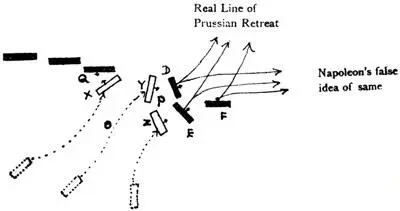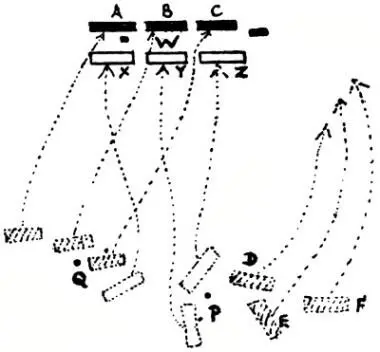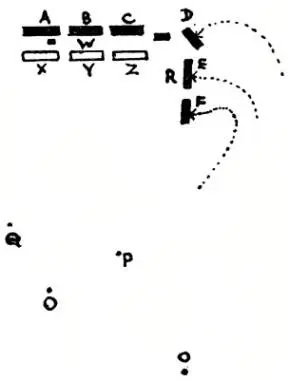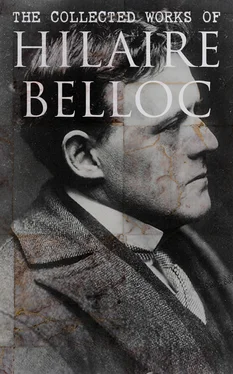Napoleon succeeds in bringing the eastern or Prussian half of this long line D E F to battle and defeating it at Ligny (P) upon the next day, Friday, June 16th, before the western half, or Wellington’s A B C, can come up in aid; and on the same day a portion of his forces, X, under his lieutenant, Marshal Ney, holds up that western half, just as it is attempting to effect its junction with the eastern half at Quatre Bras (Q), a few miles off from Ligny (P). The situation on the night of Friday, June 16th, at the end of this second step, is that represented in this second sketch map.

Believing the Prussians (D E F) to be retreating from Ligny towards their base eastward, and not northwards, Napoleon more or less neglects them and concentrates his main body in order to follow up Wellington’s western half (A B C), and in the hope of defeating that in its turn, as he has already defeated the eastern or Prussian half (D E F) at Ligny (P). With this object Napoleon advances northward during all the third day, Saturday, June 17th. Wellington (A B C) retreats north before him during that same day, and then, on the morrow, the 18th, Sunday, turns to give battle at Waterloo (W). Napoleon engages him with fair chances of success, and the situation as the battle begins at midday on the 18th is that sketched in this third map.

But unexpectedly, and against what Napoleon had imagined possible, the Prussians (D E F), when defeated at Ligny (P), did not retreat upon their base, and have not so suffered from their defeat as to be incapable of further action. They have marched northward parallel to the retreat of Wellington; and while Napoleon (X Y Z) is at the hottest of his struggle with Wellington (A B C) at Waterloo (W), this eastern or Prussian half (D E F) comes down upon his flank at (R) in the middle of the afternoon, and by the combined numbers and disposition of this double attack Napoleon’s army is crushed before darkness sets in.

Such, in its briefest graphic elements, is the story of the four days.
It will be observed from what we have said that the whole thing turns upon the incompleteness of Napoleon’s success at Ligny, and the power of retreating northward left to the Prussians after that defeat.
When we come to study the details of the story, we shall see that this, the Prussian defeat at Ligny, was thus incomplete because one of Napoleon’s subordinates, Erlon, with the First French Army Corps, received contradictory orders and did not come up as he should have done to turn the battle of Ligny into a decisive victory for Napoleon. A part of Napoleon’s forces being thus neutralised and held useless during the fight at Ligny, the Prussian army escaped, still formed as a fighting force, and still capable of reappearing, as it did reappear, at the critical moment, two days later, upon the field of Waterloo.
The rapidity of Napoleon’s stroke was marred at its very outset by certain misfortunes as well as certain miscalculations. His left, which was composed of the First and Second Corps d’Armée, did indeed reach the river Sambre in the morning, and had carried the bridge of Marchiennes by noon, but the First Corps, under Erlon, were not across—that is, the whole left had not negotiated the river—until nearly five o’clock in the afternoon.
Next, the general in command of the leading division of the right-hand body—the Fourth Corps—gave the first example of that of which the whole Napoleonic organisation was then in such terror, I mean the mistrust in the fortunes of the Emperor, and the tendency to revert to the old social conditions, which for a moment the Bourbons had brought back, and which so soon they might bring back again—he deserted. The order was thereupon given for the Fourth Corps or right wing to cross at Châtelet, but it came late (as late as half-past three in the afternoon), and did but cause delay. At this eastern end of Napoleon’s front the last men were not over the river until the next day.
As to the centre (the main body of the army), its cavalry reached Charleroi before ten o’clock in the morning, but an unfortunate and exasperating accident befallen a messenger left the infantry immediately behind without instructions. The cavalry were impotent to force the bridge crossing the river Sambre, which runs through the town, until the main body should appear, and it was not until past noon that the main body began crossing the Sambre by the Charleroi bridge. The Emperor had probably intended to fight immediately after having crossed the river. Gosselies, to the north, was strongly held; and had all his men been over the Sambre in the early afternoon as he had intended, an action fought suddenly, by surprise as it were, against the advance bodies of the First Prussian Corps, would have given the first example of that destruction of the enemy in detail which Napoleon intended. But the delays in the advance, rapid as it had been, now forbade any such good fortune. The end of the daylight was spent in pushing back the head of the First Prussian Corps (with a loss of somewhat over 1000 men), and when night fell upon that Thursday evening, the 15th of June, the French held Charleroi and all the crossings of the Sambre, but were not yet in a position to attack in force. Of the left, the First Corps were but just over the Sambre; on the right, that is, of the Fourth Corps, some units were still upon the other side of the river; while, of the centre, the whole of the Sixth Corps, and a certain proportion of cavalry as well, had still to cross!
Napoleon had failed to bring the enemy to action; that enemy had fallen back upon Fleurus, pretty nearly intact. 4All the real work had evidently to be put off, not only until the morrow, but until a fairly late hour upon the morrow, for it would take some time to get all the French forces on to the Belgian side of the river.
When this should have been accomplished, however, the task of the next day, the Friday, was clear.
It was Napoleon’s business to fall upon whatever Prussian force might be concentrated before him and upon his right and to destroy it, meanwhile holding back, by a force sent up the Brussels road to Quatre Bras, any attempt Wellington and his western army might make to join the Prussians and save them.
That night the Duke of Wellington’s army lay in its cantonments without concentration and without alarm, guessing nothing. The head of Wellington’s First Corps, the young Prince of Orange, who commanded the Netherlanders, had left his headquarters to go and dine with the Duke in Brussels.
Wellington, we may believe if we choose (the point is by no means certain), knew as early as three o’clock in the afternoon that the French had moved. It may have been as late as five, it may even have been six. But whatever the hour in which he received his information, it is quite certain that he had no conception of the gravity of the moment. As late as ten o’clock at night the Duke issued certain after-orders. He had previously given general orders (which presupposed no immediate attack), commanding movements which would in the long-run have produced a concentration, but though these orders were ordered to be executed “with as little delay as possible,” there was no hint of immediate duty required, nor do the posts indicated betray in any way the urgent need there was to push men south and east at the top of their speed, and relieve the Prussians from the shock they were to receive on the morrow.
Читать дальше















